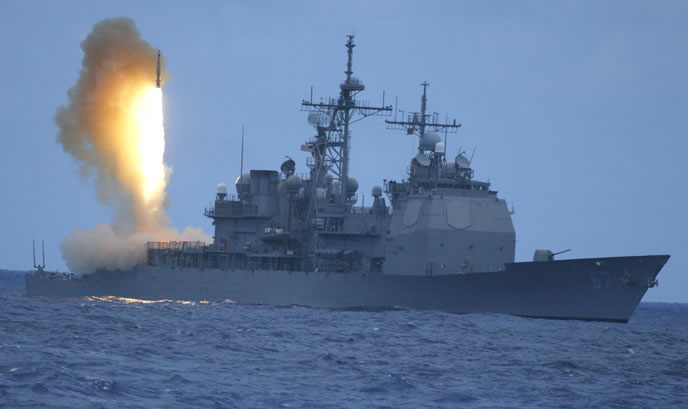Photo above: Tichonderoga class missile cruiser CG 67 Shiloh fires a Standard Missile 3 on a missile defense test. Photo: US Navy
In recent years the U.S. has increased its missile defense capability, with the introduction of enhanced capability Patriot (PAC-3) missiles, offering improved point defense against Short Range Ballistic Missiles. Sensors are also improved with AN/TPY-2 X-band radars providing detection and tracking of ballistic missiles at very long ranges andspace-based sensors – increasing early warning of missile launches. Limited trajectory tracking demonstrated by new sensors offer great opportunities for the future. Theater High Altitude Air Defense (THAAD) missile batteries will soon be deployed, improving defense against short-and medium-range ballistic missiles. While Standard Missile 3 Block IA missiles are transforming naval vessels into rapidly deployed, forward positioned sea-based Aegis systems, providing surveillance, tracking, and engagement.
The new policy on missile defense announced by the Obama administration increased the procurement of proven systems, investing in mobile and relocatable assets offering flexible and adaptable deployment options to meet changing threats. This policy has focused research and development (R&D) on enhancing the capabilities of current interceptor variants – sea based and land based, improving command, control, and battle management, and deploying more capable sensors, including Precision Tracking Space Sensor (PTSS), enabling defensive systems to establish target track and perform an intercept as early as possible.
Part of the U.S. Phased Adaptive Approach for theater missile defense, is increasing current capabilities in 2-3 year increments. An initial capability provided today by Patriot and Aegis ships at sea is being fielded now and, according to NATO spokesman James Appathurai, will be operational within weeks.
NATO’s leaders meeting this week in Lisbon will decide whether the alliance should build a missile defense for Europe, enhancing the system already being established supporting theater defense system at an investment of €800 million. According to the alliance officials, the additional budget required to enhance the system to extend its coverage to Europe is only €200 million.
2010: Today’s Missile Defense
Current deployable missile defense system is geared against short and medium range ballistic missile threats, primarily those posed by Iran. The systems consist of AN/TPY-2 forward based radars and AEGIS BMD cruisers equipped with Standard Missile 3 Block IA, all linked to linked to the command, control and battle management center (C2BMC) operations center located at Ramstein Air Force base in Germany.
2012: ALTBMD Integrates NATO Assets
A new capability to be introduced by NATO in 2012 is the Active Layered Theatre Ballistic Missile Defence (ALTBMD), a distributed network linking various radars and sensors operated by different NATO countries, embarked by NATO in 2005. The new network building on the current capabilities, expected to launch in 2012, to enable each member nation to better employ its own missile defenses assets against incoming threats. Four European nations will contribute weapons systems and sensors for ALTBMD interim capability – Germany providing Patriot Advanced Capability (PAC 3) missiles, France offering SAMP/T missiles; Italy, contributing Horizon-class frigates and the Netherlands linking its PAC-3 missiles and Air Defense Command (ADCF) frigates. The United States will allocate Aegis cruisers, Patriot missiles, and space early warning to support the European missile shield.
2015: Initial Deployment
By 2015 the current and ALTBMD capability will be enhanced with the introduction of the Next Generation Aegis 5.0 system, in land based units and naval platforms. The new Aegis version will employ SM-3 IB missiles, along with land based THAAD.
2017: Increased NATO Participation
More NATO members are expected to share their assets supporting ALTBMD in its full capability deployment, as NATO will plans to extend the system to cover ‘upper tier’ engagements, increasing detection range beyond 3,000 km. Hopefully, by that time, the new Medium Extended Air Defense System (MEADS) missile weapon systems are expected to be operational with the U.S., Germany and Italy; employing SAMP/T weapon systems and TPS 77 radars. Spain is expected to join, with Greece contributing Patriot systems, Patriot and F100 frigates, while Germany bringing new assets including the F124 frigates and Global Hawk unmanned systems online. Toward the end of the decade the U.S. will also dedicate more assets to ALTBMD, including new AN/TPY 2 radar sites in Eastern Europe and Land based Aegis and THAAD systems.
2018: Enabling Early Intercept
By 2018 the U.S. is planning to establish improved area coverage against medium and intermediate range ballistic missiles (MRBM/IRBM), with the introduction of two sites of Aegis Ashore 5.1 each equipped with SM-3 Block IB or IIA interceptors. With the Next Generation Aegis Missile (NGAM) fielded by 2020, the alliance will also have the interceptors capable of engaging targets at greater distances, extending the alliance defense against intercontinental ballistic missiles (ICBM). The distributed, deployment of defensive assets will not depend on a central operating center and rely on the distributed assets for engagement command and control.
More on the Next Generation Missiles:




















